

Louisiana Country


The Trip of a Lifetime
Youth Tour delegates visit nation’s capital Page 20








Delegates, from left, Brenna George, Madelyn Bailey, Jaylon Stephens and Lucian Gaspard visit the Capitol during their trip to Washington, D.C.
PHOTO COURTESY OF BECI



EPA’s Power Plant Rule Threatens Electric Reliability
Keeping the lights on at a cost you can afford is the focal point of everything our Louisiana electric cooperatives do. Transparency is one of our core values, so in addition to sharing co-op successes, I believe we also have a responsibility to tell you about the challenges.
In May, the U.S. Environmental Protection Agency issued a rule that impacts energy production from power plants. The power plant rule will undoubtedly threaten access to reliable electricity for our local community and communities across the country.
The rule constrains existing coal and new natural gas plants by requiring them to install carbon capture and storage—a technology that has potential but has not been proven to be viable as required. No power plant in North America uses CCS at the scale and levels mandated by EPA. When power plants aren’t able to comply with EPA’s CCS requirements, they are required to shut down, significantly limit operations or switch fuels. These unrealistic standards force the unnecessary and early shutdown of many power plants that provide reliable electricity 24/7.
Renewable sources, such as solar and water, are important components of our overall generation mix. However, given the intermittent nature of these energy sources, we simply cannot depend on them—because the sun doesn’t always shine, and water levels
in our tributaries vary depending on flooding and droughts. The need for always-available power-generating resources is still essential.
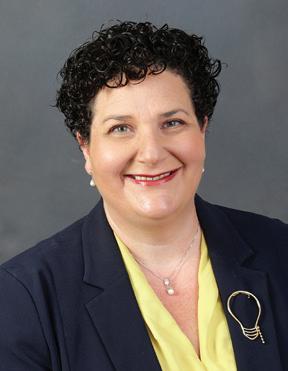
The timing of the power plant rule is equally troubling. At the same time the EPA is leading our nation down the path to fewer power plants, utilities are facing a surge in electricity demand, driven by the onshoring of manufacturing, the growth of the American economy and the rapid expansion of data centers to support artificial intelligence, e-commerce and cryptocurrency.
Many states have already experienced rolling outages. If the EPA’s power plant rule further threatens the supply of electricity, the problem will only get worse. In fact, the North American Electric Reliability Corp., the nation’s electric reliability watchdog, recently forecasted that over the next five years, all or parts of 19 states are at high risk of rolling power outages during normal peak electricity demand conditions.
It’s no secret that when demand is high and supply is low, costs go up. We’re concerned about threats to reliability as well as cost increases to our members.
Association of Louisiana Electric Cooperatives Inc.
Staff
CEO Addie Armato
SAFETY COORDINATORS Ricky Melancon Derek Seal
COMMUNICATIONS AND DIGITAL MARKETING
SPECIALIST Conley Bourgeois
ADMINISTRATIVE ASSISTANT Rhianna Garon
CREDIT UNION
Tanya Carroll, manager
Jody Overhultz, representative
Board of
Directors
President Michael Heinen
Vice President Roger Dale DeHart
Secretary/Treasurer Richard Sitman
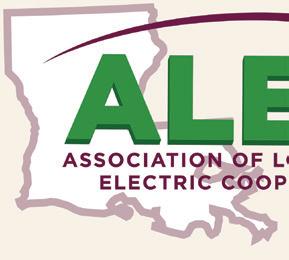

BEAUREGARD
Trent Buxton Kevin Turner
CLAIBORNE
Mike Marcotte Lane Davidson
DEMCO
Daniel Berthelot Richard “Dickie” Sitman
JEFF DAVIS ELECTRIC COOPERATIVE INC.
Michael Heinen Byron Hardee SOUTH LOUISIANA ELECTRIC COOP ASSOCIATION
Trevor Benoit Roger Dale DeHart
WASHINGTONST. TAMMANY ELECTRIC COOP INC.
Joe Jarrell Dennis Glass
Associate Member

I don’t say all of this to worry you, but I do want our members to understand the challenges that lie ahead. Just as we’ve always done, we will look for solutions that serve our members best. We are joining electric co-ops across the country to fight these regulations, and we are working with our local elected officials to help them understand the consequences this could have on all Louisiana residents and businesses.
Co-ops are no strangers to innovation, and we’re taking proactive steps to address today’s energy challenges and tomorrow’s energy needs. We’ve led the charge on industry endeavors such as community solar projects, and we’ll continue to explore new technologies and strategies that bolster reliability and our local grid.
Electric cooperatives, like the member cooperatives of the Association of Louisiana Electric Cooperatives, deliver power to 42 million Americans. At the end of the day, our priority is to meet our members’ energy needs, and we must have reliable electricity available to do that.
If you’re interested in learning more about policy impacts on power reliability or to make your voice heard on this matter, visit voicesforcooperativepower.com. We also encourage you to exercise your right to vote this election season.
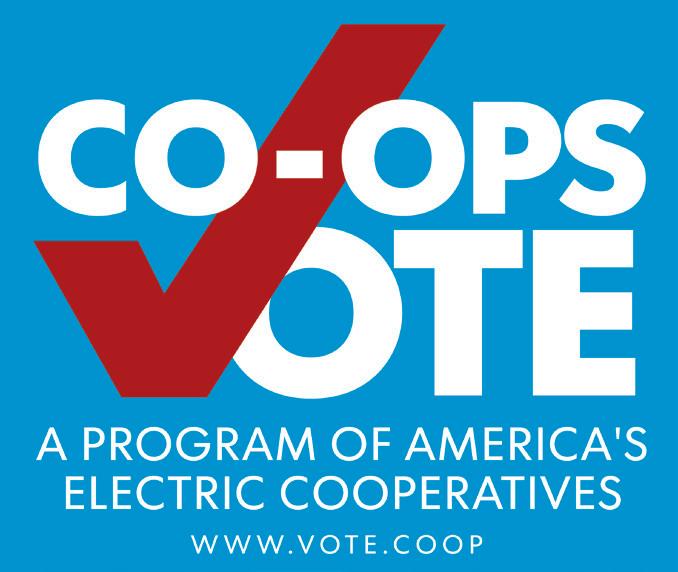
Addie Armato




BOARD OF DIRECTORS
Donald Bush | District One
Ricky Deggs | District Two
J.R. Hickman | District Three
Alan Dane Slaydon | District Four
Joey Rogers | District Five
Trent Buxton | District Six
Doug Sonnier | District Seven
Diana Backhaus | District Eight
Tommy Cryar | District Nine
BEAUREGARD ELECTRIC CO-OP LEADERSHIP
Kevin Turner | Acting Interim General Manager
Kay Fox | Vice President of Marketing and Member Services
Ronnie Marshall | Interim Vice President of Finance and Corporate Services
Kevin Aycock | Vice President of Engineering and Technical Services
Scott Deshotel | Vice President of Operations and Construction Services
BEAUREGARD ELECTRIC OFFICES
Main office
1010 E. 1st St. DeRidder, LA 70634
Phone: 800-367-0275
Moss Bluff
975 N. Perkins Ferry Road
Lake Charles, LA 70611
Phone: 337-855-6684
New Llano
12542 Lake Charles Hwy. Leesville, LA 71446 Phone: 337-239-3451 www.beci.org
Volume 41, Issue 5
Louisiana Country (USPS 473-180) is published bimonthly by the Association of Louisiana Electric Co-ops Inc., 10725 Airline Hwy., Baton Rouge, LA 70816, in partnership with Pioneer Utility Resources.
Annual Subscriptions: Members $2.30. Nonmembers $5.
Postmaster: Send form 3579 to 10725 Airline Hwy. Baton Rouge, LA 70816.
Periodicals postage paid at Baton Rouge, Louisiana 70821 and additional mailing offices.
Message From the Acting Interim General Manager
Things You Might Not Know About Power Restoration
Have you watched a video or TV show where a person is cooking a meal, then suddenly they snap their fingers and the meal is plated and ready to eat? That’s called a jump cut.
While we wish we could “jump cut” from a power outage to power restoration, it often takes a lot more effort and people to make it happen.
We’re accustomed to members’ questions about power outages and why it can take time to get the lights back on. Given everyone’s reliance on electricity, there’s simply never a good time to be without it. Here are things you might not know about restoration:
• Our employees might be affected, too. Because Beauregard Electric Cooperative Inc. is a local electric cooperative owned by the members it serves, employees are local, too. They are your neighbors, friends and familiar community volunteers. When you’re without power, our people might be, too.
• It’s a team effort. Every BECi employee works to get your power restored as soon as possible. Our member service representatives take calls; engineers and field staff survey damage; our vegetation management team clears hazards; dispatchers organize crews; and communicators keep everyone informed of progress or potential dangers. When your power goes out, we all work together as quickly and safely as possible to restore it.
• We assess the situation first. Every outage is different, and we don’t know how dangerous it is or whether equipment needs to be replaced. When responding to outages, we first need to see what happened, then figure out which materials we need and a plan for how to fix the problem(s) without compromising electric flow for other members.
• Restoration is normally prioritized by the largest number of members we can get back on in the shortest amount of time. Our crews focus on responding first to public safety issues and critical services. Then we complete work that impacts the largest number of people.
• Our employees face many dangers. Besides working around high-voltage electricity, our crews are on alert for wild animals, weather elements, falling trees and fast-moving cars. If you ever drive past one of our vehicles, please do so slowly.
• Flickering lights are a good thing. Some folks mistake flickering lights for outages, but these “blinks” are important because they indicate our equipment works and prevent possible outages that can be caused by animals or tree limbs on the lines.
• We do our best to help all who need it, but if you depend on electricity for life support purposes, have a backup plan. Remember, we don’t always know how long restoration efforts will take. If you’re unsure what to do, call us so we can help you prepare.
• Our employees have to plan and eat. If you ever see our trucks in a restaurant parking lot while your power is out, know that sometimes our employees huddle in a safe, common area to map out their strategy for getting your power back on. Also, our crews work long, hard hours during outages and need to take time for meals, just like everyone else.
• Sometimes it’s a waiting game. Our portion of the power grid is connected to other utilities, and we maintain positive relationships with power providers interconnected to our system. If our outage is due to an issue from their feed into our system, we must let them repair it and be mindful of what they’re going through to fix it.
We do our best to avoid power disruptions, but they are inevitable from time to time. If the lights go out, know your co-op team is working as quickly as possible to restore power.
You Could Win a $50 Bill Credit
Beauregard Electric offers its members an opportunity to win the co-op’s Lucky Account Number Contest by publishing four account numbers somewhere on pages 20-21 of Louisiana Country. The account numbers are listed within the story on those pages, not on the magazine cover. To win, you must locate your account number (listed on your electric bill) on these pages and then contact the co-op. To claim your prize, call 800-367-0275 or 337-463-6221 by Oct. 15.

A Tabernacle Prayer
You can’t understand me unless you have insight into how Dry Creek Baptist Camp has shaped my life.
I got my first job there at age 13. I oversaw picking up glass soda bottles on the grounds for deposit return.
After that summer, they couldn’t run me off. I’ve been part of Dry Creek Camp since 1969.
At that young age, I had no idea—and no one else did either—that I’d serve as camp manager one day.
My mind went back to one of my favorite camp stories.
The late 1960s and ’70s were interesting times at Dry Creek Baptist Camp. The youthful rebellion of the ’60s had finally hit rural Louisiana, and the battle had begun.
All authority seemed to be in question— even at camp. Redneck boys who had two years earlier sported flat tops now had shoulder-length hair and muttonchop sideburns. The girls tried to show their rebellion with miniskirts that were shorter than ever.
My generation had to test every limit.
One way camp authority was tested was when boys tried to slip out of the cabin at night.
Routinely, boys would climb out a window of the old dorms and roam around.
In 1970, two local teen boys were caught outside by the night watchman. The next day, the camp director, a pastor, gave them the choice of being sent home or apologizing to the entire camp for their misdeed.
I’m sure the guys contemplated this option. They sure wanted to stay at camp, but the idea of apologizing in front of all their friends, as well as 200 female admirers, was a bitter pill to swallow.
Nevertheless, they agreed.
That night, there was a huge crowd at the service. The camp director introduced both boys who nervously stepped to the microphone.
After clearing his throat, the first boy said, “I’m very sorry I was outside in the dark last night. It was wrong, and I take full responsibility for this. I ask you to forgive me.”
The auditorium erupted into clapping
mixed with shouts of “amen” and “you’re forgiven.”
The pastors and other youth leaders in the audience nodded their heads in approval as the smiling camp director put an arm around the first boy’s shoulder.
This was truly repentance of the highest order.
Now it was the second boy’s turn. He stepped up to the microphone.
I thought to myself, “Just repeat what he said, and you’ll be fine.”
However, he had worked out his own speech. As I remember it, he said, “Well, I’m sorry I was out last night.”
He took a deep breath, then continued, “But most of all, I’m sorry I got caught.”
There was an eerie silence in the tabernacle. No one knew what to say or do.
In my 14-year-old mind, I wondered if that was an apology.”
However, there was no doubt what the camp director was thinking. He roughly grabbed the second boy by the arm and unceremoniously led him from the stage.
As they went out the side door, he was giving the boy an earful.
That story told decades ago was my first introduction to the difference between Godly repentance and worldly sorrow.
You see, true repentance from God is sorry for the sin.
A repentant person wants to change directions, make amends and do right— regardless of whether they got caught or the awaiting consequences.
However, worldly sorrow simply is sad they got caught. It’s already thinking, “Next time, I’ll be more careful or crafty.”
The sorrow of the world doesn’t change a person.
However, I’m so thankful Godly sorrow does change a person. Repentance isn’t simply to change directions from the path we were on. It is a 180-degree variation.
I describe it as, “You’re standing in front of the camp, and you step out onto Highway 113. You’re walking south to Reeves, and you stop, turn and walk north toward Sugartown.”
“Godly sorrow brings repentance that leads to salvation and leaves no regret, but worldly sorrow brings death.” -2 Corinthians 7:10
Tabernacle Prayer
“Dear Lord, as I sit in the back of this old building called ‘the tabernacle’ at Dry Creek, I’m reminded of all the great things you’ve done in it.
Above the loudness of youth singing and the echoes of sermons from your word, I can hear your sweet, still, small voice above all the other things I’ve heard.
As I look up at those exposed rafters, I sure do wish they could talk.
All the stories they’d tell of lives changed here by you.
Souls changed by the power of your love, never to be the same again.
Missionaries and pastors who first heard your call, “Go and tell,” while worshipping in this building.
Lord, thank you for using this camp and the tabernacle on these grounds.
To speak to thousands of lives over the years.
But Lord, your power isn’t confined to any building, for your Spirit works everywhere. You’re ready to use people and buildings when we’re simply open to your will.
But I’m surely thankful you’ve chosen to work in such a way at Dry Creek Baptist Camp.
Thank you for all the marvelous things you’ve done here in the past, but most of all, Lord, thank you for what you will continue to do at your camp.
As we plan and look to the future, lead us as we plan.
Let everything we do be guided by your strong hand.
And let my life be your tabernacle; a place where you’re welcome to dwell.
Always remembering that without Your presence, no building or person is complete.
In Jesus’ name, amen.”
“Tabernacle Prayer” comes from “Stories from the Creekbank.”

Curt Iles lives in Central Louisiana. He is a graduate of Louisiana College and McNeese State University. He served as a teacher, coach, principal, camp director, missionary and writer. To see more work by Curt, visit www.creekbank.net.
Annual Meeting Awards
The Louisiana Member Services Association and Association of Louisiana Electric Cooperatives recognizes cooperative employees and their families for the volunteer work they do in their communities. This year, LMSA members decided to permanently rename two awards, one for a cooperative and one for an individual, as the Kevin Reeves Cooperative Spirit Award after a beloved cooperative employee.
Kevin spent his 33-year career at Beauregard Electric Cooperative. He was a friend to many in the industry, and he truly lived a life marked by selfless service and boundless love. Kevin’s unexpected death in June 2023 left a profound void in his family, church, community and electric cooperatives across the country. Kevin’s life was a direct reflection of everything the awards program symbolizes, and no one deserves to be the namesake of these awards more.
This year’s nominees:
Starla Pruitt, BECi. Starla runs races for benefits, fundraisers and several nonprofit organizations. Since 2018, she has competed in more than 20 races, from 5Ks to half-marathons, bringing awareness to multiple causes.
Candy Hardy, Claiborne Electric Cooperative. As a court-appointed special advocate, Candy fights for the best interest of children who have been removed from their homes by the Department of Children and Family Services.
Cecil Garaudy, DEMCO. Cecil travels to various fundraisers and volunteer opportunities with his 20-year-old African sulcata tortoise, Thomas. Cecil and Thomas are an audience favorite at their public outings, where they raise awareness and funding for various causes.
Tina Diehl, Jeff Davis Electric Cooperative. Tina provides

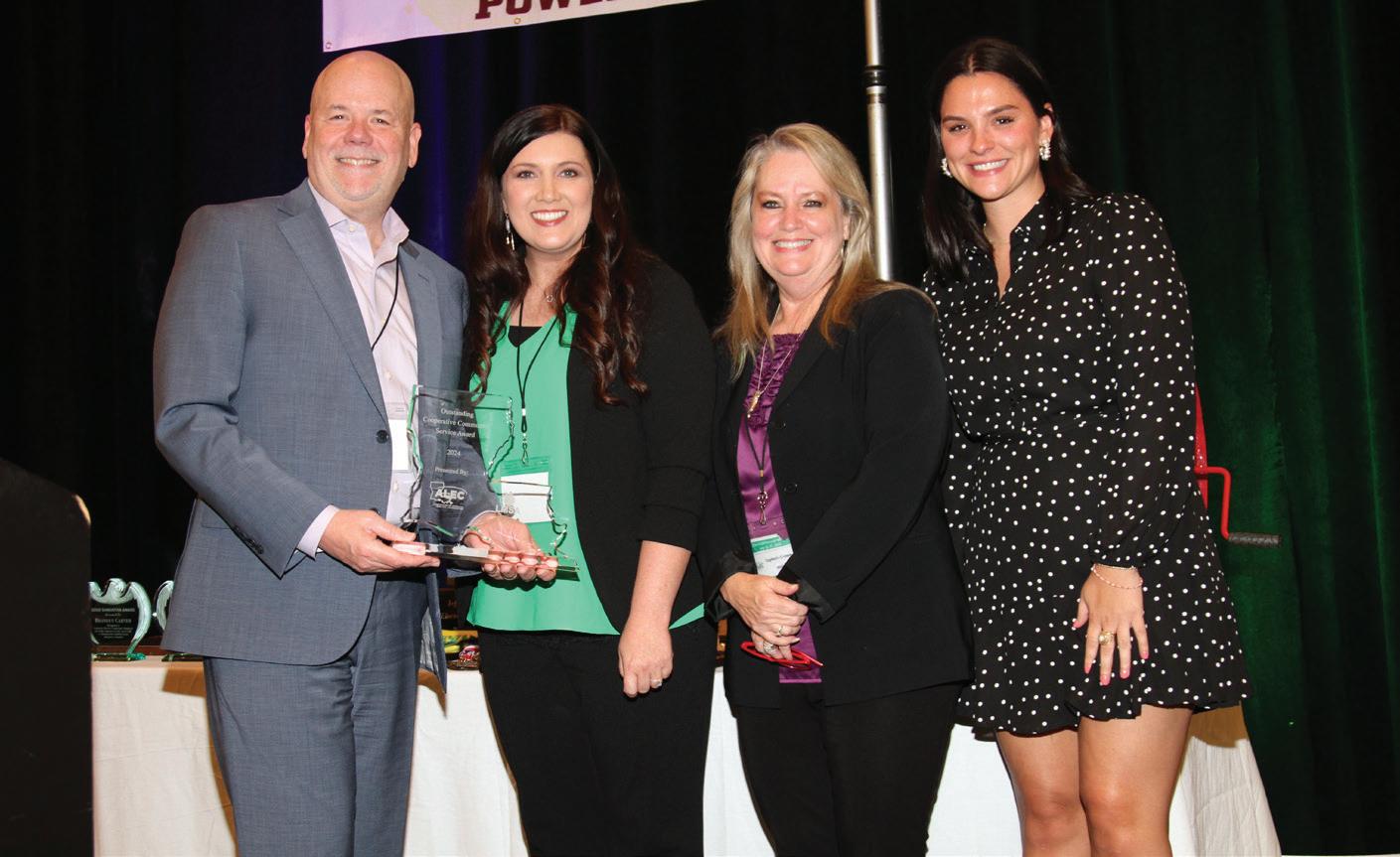
communications services for The Catholic Daughters of the Americas, an organization that collects new or gently used shoes for countries in need. In 2022, the group collected nearly 4,000 pairs of shoes.
William Howell, Washington-St. Tammany Electric Cooperative. William volunteers with the Liars and Lunkers free fishing tournament, which was founded
by his father and uncle. The event introduces children to the world of fishing as an alternative to drugs.
Candy Hardy was named the winner of the individual Kevin Reeves Cooperative Spirit Award.
Additionally, WSTE won the co-op award for its community project “Team Up To Clean Up/Love the Boot.” n
From left, Candy Hardy, Claiborne Electric Cooperative; William Howell, Washington-St. Tammany Electric Cooperative; Starla Pruitt, Beauregard Electric Cooperative; Cecil Garaudy, DEMCO; and Tina Diehl, Jeff Davis Electric Cooperative, were nominees for the individual Kevin Reeves Cooperative Spirit Award. Candy was this year’s winner.
Left, Dane Hocott, Washington-St. Tammany Electric Cooperative, accepts the co-op Kevin Reeves Cooperative Spirit Award from Louisiana Member Services Association representatives Emmalee Tingle, Claiborne Electric Cooperative; Coylean Schloegel, WSTE; and Conley Bourgeois, Association of Louisiana Electric Cooperatives.
Honoring Excellence in Safety and Service
At the 2024 Association of Louisiana Electric Cooperatives Awards and Safety Banquet in July, cooperatives and individuals were celebrated for their accomplishments throughout the year.
ALEC provides many services to its member cooperatives, but the most beneficial and impactful offerings are the safety and training programs. Cooperative employees work in dangerous environments every day, and ALEC’s goal is to train them to do their jobs safely.
“The safety and training programs that ALEC provides are vital to our co-ops,” says Derek Seal, ALEC safety coordinator. “They ensure all co-ops are up to date on new strategies and compliant with OSHA guidelines.”
ALEC employees, with the help of toptier line professional representatives from all Louisiana co-ops, ensure all apprentices and lineworkers get the best knowledge and safe practices to be the best at what they do daily.
ALEC member cooperatives can participate in the Rural Electric Safety Achievement Program, which requires rigorous safety inspections every three years by a certified team of loss-control professionals that inspect everything from plant and equipment to employee procedures.
This year, DEMCO and WSTE completed the RESAP inspection and received a flag to display at their headquarters.
ALEC member cooperatives that have worked without a lost-time accident are given plaques in recognition of their achievements. The recipients were:
• Jeff Davis Electric Cooperative, in recognition of working more than 752,191 work hours without a lost-time accident since January 2017.
• South Louisiana Electric Cooperative Association, in recognition of working more than 4,570,467 work hours without a lost-time accident since December 1996.
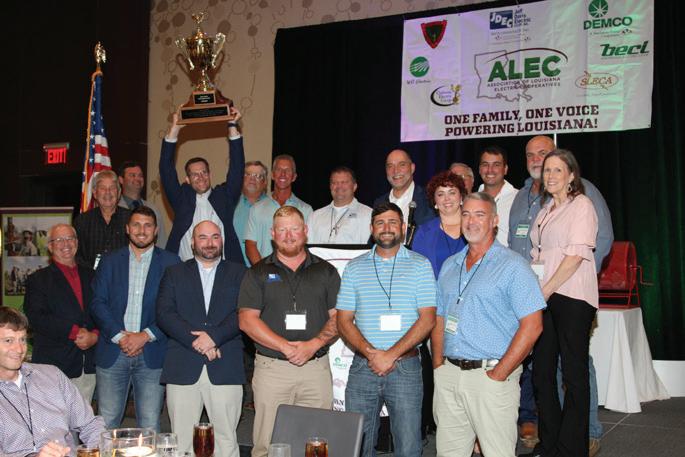
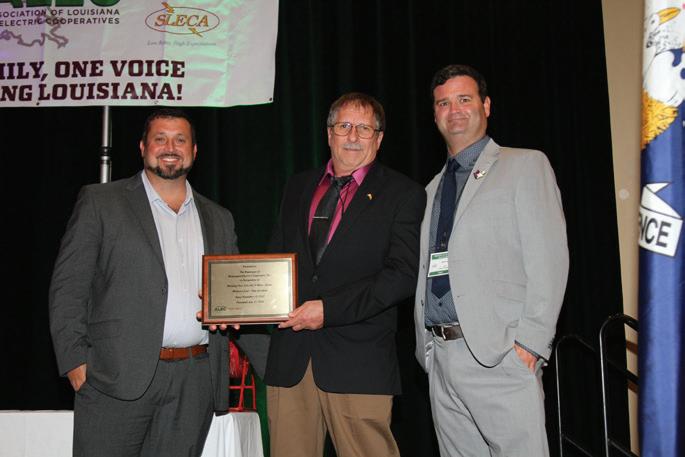
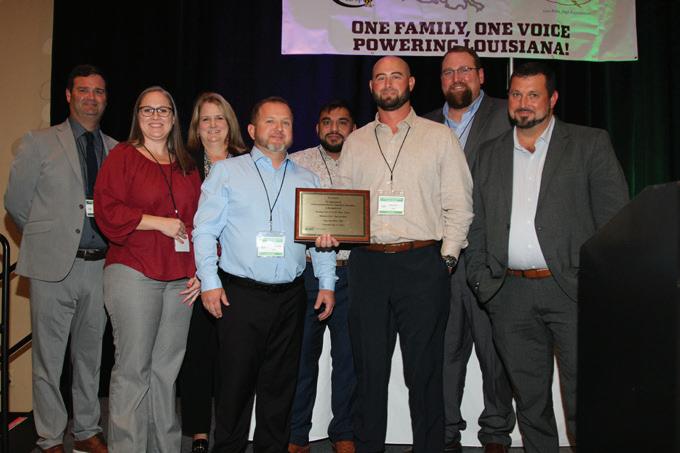

• Beauregard Electric Cooperative, in recognition of working 428,248.70 work hours without a lost-time accident since November 2022.
• Claiborne Electric Cooperative, in recognition of working more than 691,711 work hours without a lost-time accident since June 2019.
The Traveling Statewide Safety Award is always the last presentation. A special formula is used to determine the winner, incorporating employees’ incidents, incident severity, hours worked and vehicle accidents.
Jeff Davis Electric received the prestigious statewide safety trophy for the second year in a row.
ALEC commends all member cooperatives for their achievements and continued commitment to safety. n
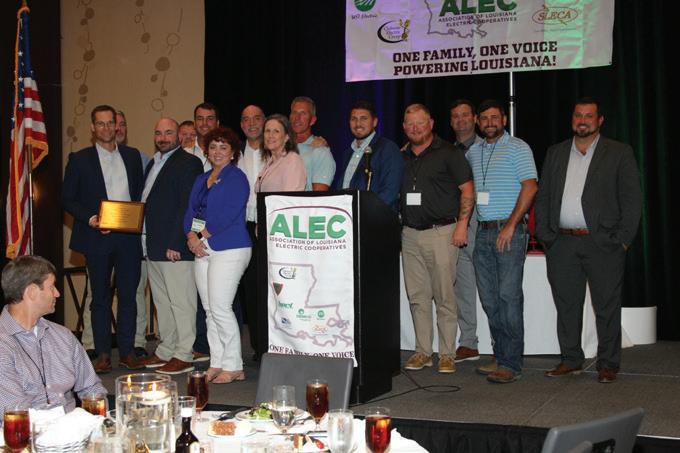
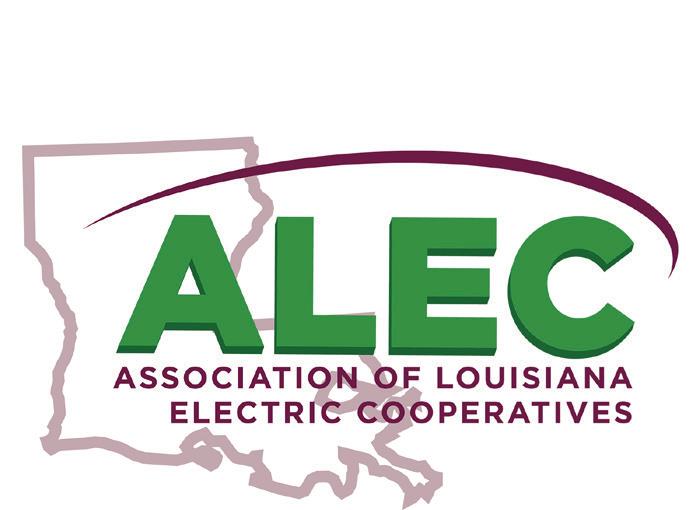
Beauregard Electric Cooperative employees accept the co-op’s No Lost Time Award.
Claiborne Electric General Manager Mike Marcotte accepts the co-op’s No Lost Time Award.
Jeff Davis Electric Cooperative employees accept the co-op’s No Lost Time Award.
Jeff Davis Electric Cooperative employees accept the 2024 Statewide Safety trophy.
South Louisiana Electric Cooperative Association employees accept the co-op’s No Lost Time Award.
























Pay By Barcode
When Beauregard Electric Cooperative Inc. began looking for another convenient way for its members to pay bills, Meridian Cooperative—BECi’s data processing vendor—partnered with local and national retail stores to offer a barcode system to take payments in real-time for BECi members.
Since BECi implemented the program in January 2024, the
co-op’s members have partnered with 40 separate locations across three states and 23 cities.
Finding your barcode is as simple as visiting beci.org or https://beci.meridiancheckout.com/Lookup.
The stores pictured below are available to accept payment by barcode.

|
































































Calcasieu Marshes












Brackish estuary can produce varied fish bonanza
Story and photos by John N. Felsher









Well known for producing giant speckled trout, the Calcasieu Estuary south of Lake Charles offers anglers more to catch.
Calcasieu Lake, locally known as Big Lake, runs about 12 miles long by 9 miles wide and covers roughly 50,000 acres. The Calcasieu Ship Channel runs 40 miles from Calcasieu Pass on the Gulf of Mexico to Lake Charles, connecting Big Lake and other water bodies.

To the west, the Sabine River flows down the Louisiana-Texas line into Sabine Lake. Sabine Lake spreads across 45,320 acres. At the south end, Sabine Pass connects the lake to the gulf.
The Gulf Intracoastal Waterway connects the Calcasieu Ship Channel to Sabine River. A vast brackish marsh provides outstanding angling opportunities for multiple fish species between the two major lakes from the GIWW south to the gulf.
Sabine National Wildlife Refuge conserves nearly 125,000 acres of this pristine wilderness punctuated by numerous impoundments, bayous, canals and ponds. In the marshes between the lakes, anglers can catch anything that swims in Louisiana waters.
Fresh water from the Sabine and Neches rivers pours into the northwestern portion of the marshes, where it mixes with salty


In the tidal waters of the Calcasieu Estuary, anglers can catch freshwater and salty species at the same time in the same place, often on the same baits. From left, a channel catfish, blue catfish, redfish, largemouth bass, speckled trout and sheepshead.
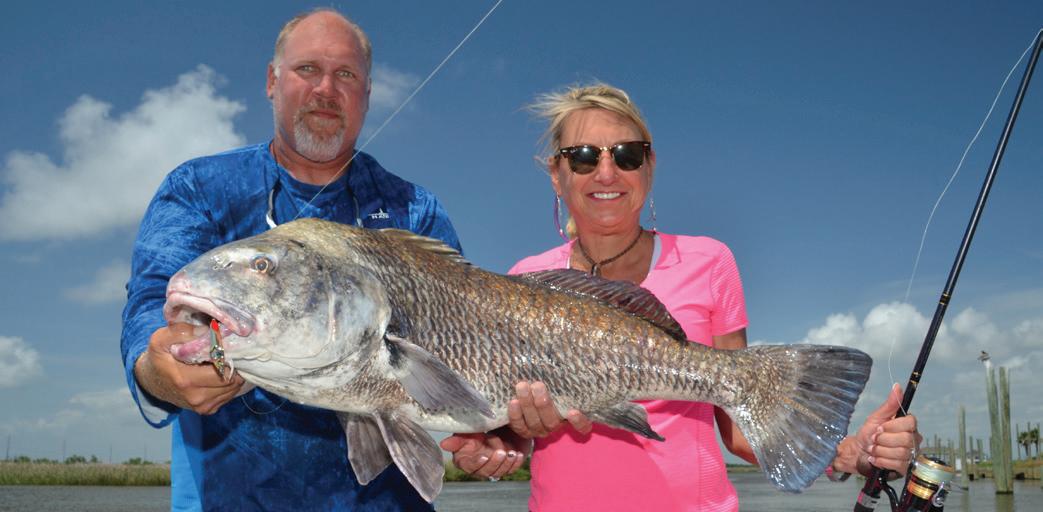

water coming from the gulf through the passes. On the eastern side, fresh water pours down the Calcasieu River into the northern part of the Calcasieu Estuary.
The blurred demarcation between the two environments blends and moves constantly as river flow, tides and wind battle for dominance. This fertile mixing of sweet and saline worlds creates a piscatorial gumbo, providing homes to a multitude of diverse species.
Predators feast upon the best forage from both worlds. Bass, redfish, trout and flounder gorge themselves on a rich smorgasbord of aquatic and marine morsels such as threadfin shad, crawfish, bream, crabs, shrimp, cocahoe minnows, menhaden, known locally as pogies, mullets, croakers and uncountable other creatures.
Largemouth bass can tolerate salinity up to about 10 parts per thousand. Blue catfish can tolerate salinity better than most other freshwater species. Redfish and flounder can live in pure, fresh water. Most other salty species tolerate varying salinity levels. On any day, the catch might include these fish, plus speckled trout, white trout, black drum, sheepshead, several bream species, crappie, fresh and saltwater catfish and others.
“Many diverse species hang out all together in the same places,” says Tom Adams Jr. of Fishing Tom Guide Service in Sulphur. “It’s not too salty for freshwater species, and it’s salty enough for many saltwater species. We might catch 15 or more different species in one day.”
What one catches in a particular spot at any given time depends upon salinity levels at that spot, which can sometimes fluctuate hourly. Anglers might catch mostly bass from one spot early in the morning or some redfish and flounder. Later in the day, they might catch mostly speckled trout in the same spot with the same baits.
“Most bass in the marsh average about 1 to 2 pounds, but anglers specifically targeting bass sometimes catch 5- to 6-pounders,” Tom says. “In some bass club tournaments, anglers have caught bass in the 8- to 10-pound range.”
Nothing ignites a multispecies feeding frenzy like a fall crustacean migration. After a good cold snap, white shrimp leave the estuaries to head for deeper waters. As shrimp move, everything follows. No predator will refuse a shrimp snack. Largemouth regularly hit live shrimp or soft-plastic shrimp imitations, such as Vudu, D.O.A. or Gulp!, fished under a popping cork.

“Bass absolutely love live shrimp,” Tom advises. “In September and into the fall, we fish grass lines with live shrimp under a popping cork for both bass and redfish. For redfish, I like to work the main bayou shorelines. I look for flowing water. We also catch many flounder in the same places, especially in the fall.”

Black Bayou flows through the northwestern portion of those marshes and provides excellent fishing opportunities for varied species. Multiple small tributaries feed into the bayou. During a falling tide, dropping water levels pull baitfish, shrimp, minnows and crabs from the marshes and ponds into deeper water. Bass, redfish, flounder and other species wait at the mouths of small drains to ambush anything washing out with the tide.
“Black Bayou can produce excellent action,” Tom says. “It usually has moving water. The bayou averages about 8 to 10 feet deep, but some holes drop to 14 feet deep. Redfish like to hang out in the holes as water temperatures cool in the fall.”
In the drains, many anglers fish live shrimp, or a soft-plastic shrimp imitation, under a popping cork. Toss the cork as far up the drain as possible. Let the tide carry the cork naturally downstream. Use the reel only to take up slack and keep the bait in the flow.
Anglers can also fish the Vinton Drainage Ditch, which crosses the Intracoastal and merges into Black Bayou. The East Cut connects the north end of Sabine Lake to Black Bayou.
“Trout action depends largely on salinity levels,” Tom says. “We usually find specks closer to Sabine Lake. In the marshes, trout average about 12- to 15-inches long, but it’s not uncommon to catch a limit of 15-inch trout, especially in the fall.”
Closer to the Calcasieu side, the Black Lake area produces great fishing action for trout and other salty species. The Salt Ditch runs from the GIWW to the Black Lake area and regularly produces good trout action. Kelso Bayou connects Black Lake to the Calcasieu Ship Channel. People can fish off the bank along Highway 27.
“The waters around Black Lake are very good for redfish, trout, flounder and other saltwater species,” Tom says. “In the marshes, we never know what might grab the line, especially when we put a live shrimp on a hook. It’s always a surprise what we bring in. That’s what makes fishing this area so exciting!”
For information on Sabine National Wildlife Refuge, visit www.fws.gov/refuge/sabine. For area information, go to www.visitlakecharles.org.
To reach Fishing Tom Guide Service in Sulphur, call 318-675-9114 or go to www.fishingtom.net.

Tom Adams Jr. of Fishing Tom Guide Service in Sulphur and Karen Lutto show off a black drum she caught on an Al’s Goldfish spoon while fishing in the Calcasieu Estuary, south of Lake Charles.
Devon Shaheen of Fishing Tom Guide Service in Sulphur caught this flounder in the Black Lake area of the Calcasieu Estuary, south of Lake Charles.
GET OUT THE i n LOUISIANA

YOU VOTE?
Voting is one of the most powerful ways to make your voice heard in our democracy, but in 2020, only 66.8% of the voting-age population in the United States reported voting.
Modern technology has improved access to information on candidates and made it easier to register to vote in many areas, and it is vital to be aware of how you can participate in the 2024 election cycle.
LOUISIANA’S ABSENTEE AND MAIL-IN VOTING PROCEDURES
Permanent absentee / mail-in voting procedures:
Excuse required to request an absentee ballot Applications can be submitted via mail, in-person, email, fax, and online
LOUISIANA’S EARLY VOTING DEADLINES
Early Voting Begins: October 22, 2024
Early Voting Ends: October 29, 2024 WHY SHOULD
DEADLINES TO KNOW FOR VOTING IN LOUISIANA
VOTER REGISTRATION DEADLINE: October 6, 2024
30 days before an election; 20 days before if registering online.
ABSENTEE / MAIL-IN VOTING
BALLOT DEADLINES:
Request must be received by
November 1, 2024
4 days before the election at 4:30 p.m.
To register to vote in Louisiana, visit the State Board of Elections website for more information on voter eligibility and the registration process.
BALLOT SUBMISSION DEADLINE:
All absentee ballots, regardless of return method, must be received the day before the election.
You can begin the registration process through Louisiana’s Online Voter Registration System.







Committee for Rural Electrification® (ACRE®) to electric cooperatives in their local just that.
action committee (PAC), and it continues to to electric co -ops.

Connecting Policymakers to the Co-op Mission
it’s impo rtant that candidates who receive the PAC and the electric cooperative conduct research to ensure electric co -ops research and discussions with individuals that many of today’s political candidates
NRECA fuels a powerful resource
An effort to support policymakers and initiatives that further the cooperative mission received a fresh name last year: America’s Electric Cooperatives PAC. As it goes into its first presidential election season, the organization continues a mission that began nearly six decades ago.
for our PAC: America’s Electric Cooperatives

A political action committee, or PAC, allows donors to support political candidates. Thousands of donors have contributed to the America’s Electric Cooperatives PAC, according to the National Rural Electric Cooperative Association.
“The name change just makes sense,” says Gabe Snow, the PAC’s director. “If we’re going to have a large PAC, we need to make sure it’s identified appropriately to help ensure electric co-ops are recognized for our collective efforts.”
activities of the PAC under the well-known and resources, including the Voices for Cooperative recognizable brand that enhances our reputation. This electric co-ops is purposefully designed to elevate evidence that this approach is working well.

Discussions with individuals associated with federal politics and PAC donors found many of today’s political candidates did not connect ACRE with electric co-ops.
So, NRECA unveiled America’s Electric Cooperatives PAC last year, enabling the association to better connect PAC activities to the nation’s well-known and respected co-ops. The rebrand created an umbrella encompassing not only the PAC but also other advocacy resources, such as the Voices for Cooperative Power grassroots network.
That vision led to a name change for the PAC that began in 1966, when NRECA established the Action Committee for Rural Electrification, known as ACRE.
At the time, the use of acronyms to identify such groups was less common than it is today. Research supported by NRECA indicated co-ops did not receive full recognition for their collective efforts.
PAC Quick Facts
through personal dollars raised from co -op candidates, who if elected become

“The name America’s Electric Cooperatives PAC capitalizes on the fact that electric cooperatives are already held in high regard in Washington, D.C., through our collective advocacy efforts,” Gabe says. “It capitalizes on that brand and the reputation NRECA has as a strong bipartisan organization.”
A simple, straightforward PAC name is especially important in dealing with first-time federal candidates, Gabe says.
“Every two years, hundreds of congressional elections take place, and new candidates enter the field,” he says. “That constant churn happens over and over again, and it’s easy to get lost in the alphabet soup of acronyms in Washington.”
America’s Electric Cooperatives PAC allows electric co-ops to financially support federal candidates.
Funding: Funds include personal dollars raised from co-op leaders and consumer-members.
The goal: The PAC strives to ensure that candidates, if elected, become policymakers who connect the PAC with electric co-ops.
member co -ops and the feedback we’ve received to manage America’s Electric Cooperatives at NRECA PowerXchange.
The details: America’s Electric Cooperatives PAC is nonpartisan, advocating for policies and legislation supporting our electric co-ops.
For more information or to donate, visit cooperative.com/pacdonation.


have a robust Voices for Cooperative Power op employee and consumer-member tap into thousands of cooperative CEOs and and regulatory advocacy teams at NRECA.
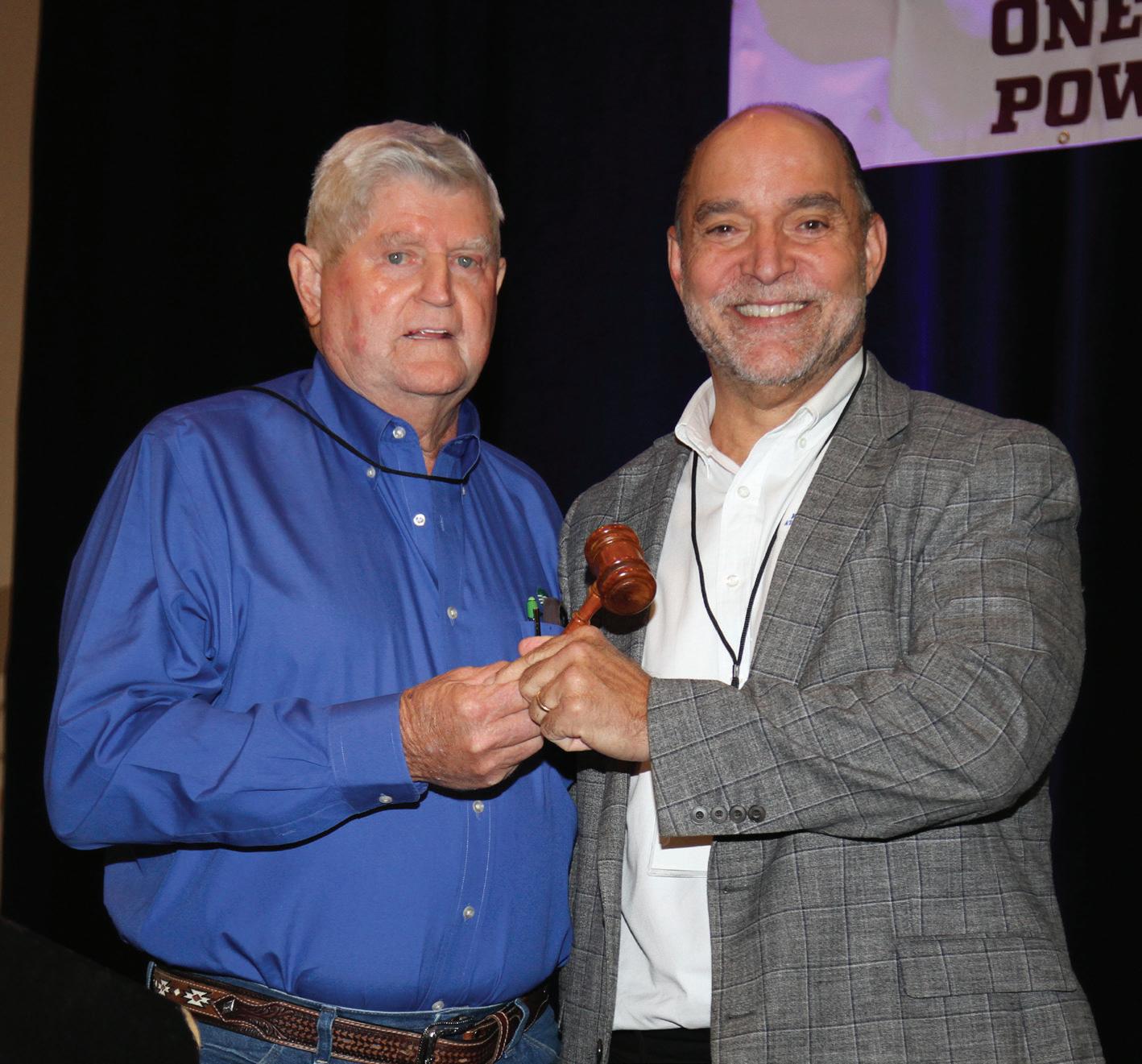
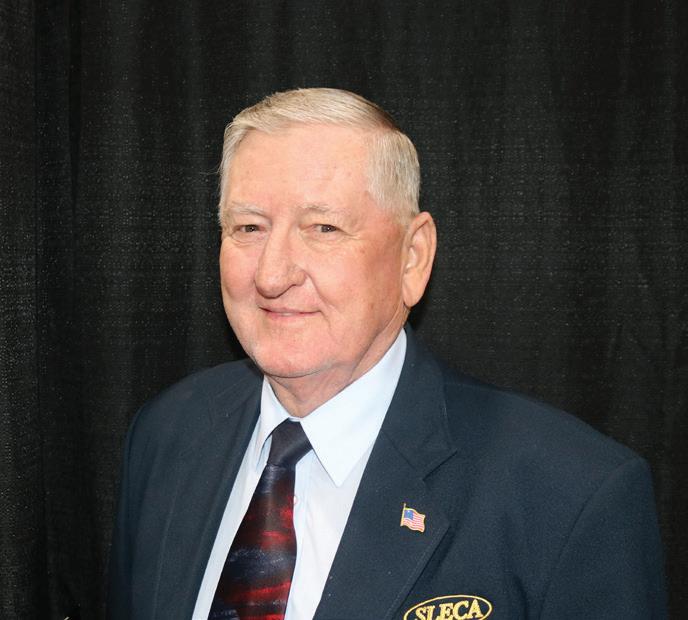

CLOCKWISE FROM ABOVE: Association of Louisiana Electric Cooperatives outgoing board president, Dennis Glass of Washington-St. Tammany Electric Cooperative, passes the gavel to the newly
Davis Electric Cooperative. Roger Dale DeHart of South Louisiana Electric Cooperative
was
as vice president. The 2024-2025 secretary/treasurer is Richard Sitman of DEMCO.
New Leadership Elected at 2024 Annual Meeting
New directors and officers announced

At the 2024 Association of Louisiana Electric Cooperatives Annual Meeting, the ALEC Board of Directors elected the following slate of officers for 20242025: President Mike Heinen, Jeff Davis Electric Cooperative; Vice President Roger Dale DeHart, South Louisiana Electric Cooperative Association; and Secretary/ Treasurer Richard Sitman, DEMCO.
“I am excited to continue to contribute to our cooperatives’ shared vision,” said Heinen. “We are well positioned to make a lasting impact on the communities we serve.”
Also appointed by their respective cooperatives to serve three-year terms as ALEC drectors are Mike Marcotte, Claiborne Electric; Dennis Glass,
Washington-St. Tammany Electric Cooperative; and Trent Buxton, Beauregard Electric Cooperative Inc.
“We are proud to announce our new board of directors and officers,” said ALEC CEO Addie Armato. “Our board of directors has been instrumental in providing our statewide organization with strategic guidance to better serve our cooperative members. We value their ideas and give them an equal voice at the table.”
Under the direction of the board, ALEC will continue to provide its members with innovative educational opportunities, award-winning magazines, safety and loss control programs, and a strong presence in both legislative and regulatory matters. n
elected president Mike Heinen, CEO of Jeff
Association
elected
G� A�o�e a�d B�y�n� f�r a S�f�
Modern farming often relies on data and equipment with GPS and auto-guidance systems. However, even with these modern conveniences, farm workers must remain vigilant. That’s because farming is considered one of the most dangerous jobs.
Massive machinery is indispensable to farming, but the same impressive size, height and extensions make them particularly vulnerable to contacting power lines. That’s why staying alert, focused, and knowledgeable about potential hazards and safety procedures is crucial.
During a busy harvest season, the familiar sights around the farm can easily fade into the background, and farm workers can overlook the power lines overhead. However, failing to notice them can lead to deadly accidents.
360 Awareness
Awareness of your surroundings around, above and below, as well as planning safe equipment routes can significantly reduce the risk of accidents. Even with GPS and auto steering, it’s imperative that farm workers keep a close eye on the equipment’s location and are ready to act if necessary.
Exposed underground power lines, defective wiring in farm buildings and extension cords are also hazards.
Grain bins can pose a potential danger as well. The National Electrical Safety Code requires power lines to be at least 18 feet above the highest point on any grain bin with which portable augers or other portable filling equipment are used.
If you plan to install new grain bins or you’re concerned about the proximity of power lines to existing grain bins, contact Escambia River Electric Cooperative.
Smart Harvest Safety Tips
To ensure a safe harvest season, SafeElectricity.org recommends the tips in the graphic below to avoid electrical accidents on the farm.
While rare, an equipment fire is the only reason to exit machinery that has come into contact with overhead lines. If it happens, jump off the equipment with your feet together. It’s critical you not touch the machinery and the ground at the same time. Then, still keeping your feet together, hop to safety as you leave the area. n
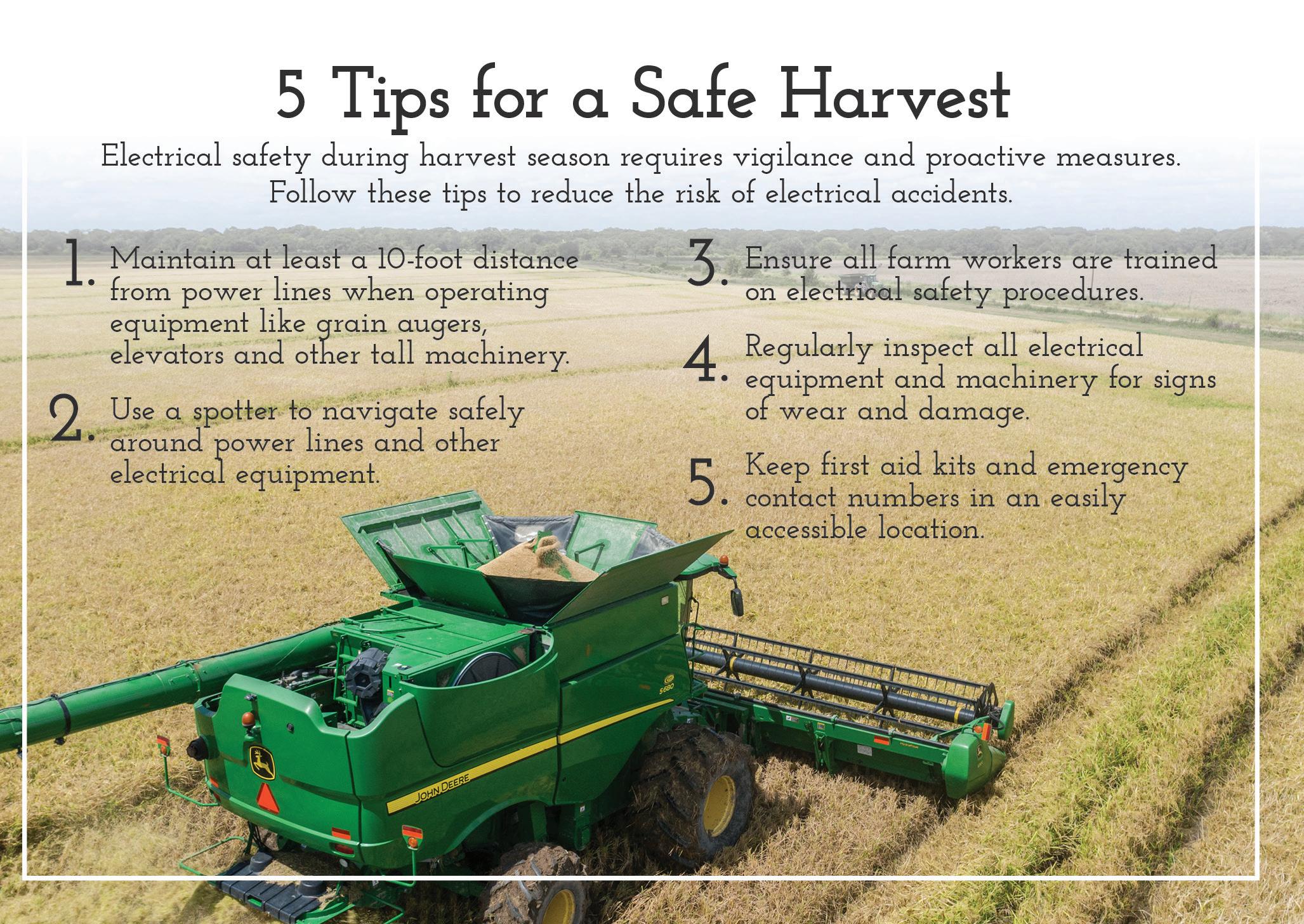

































In Remembrance of Kevin Reeves
Say the name Kevin Reeves at any electric cooperative in Louisiana—any electric cooperative in the South, for that matter— and you will find people who call themselves Kevin’s friends.
Kevin started his career at Beauregard Electric Cooperative Inc. in 1987. He spent 33 years serving the co-op’s communities, members and employees. He was a personal friend of every co-worker he had in those 33 years.
While working for BECi, Kevin was a pivotal member of the Louisiana Member Services Association. After retiring, Kevin continued serving cooperatives in the South through his work with RANCO Response.
In February 1989, Kevin married the love of his life, Suszanne, and they had two children—Andrew and Keri. They gained a second daughter when Andrew married Lakyn. Kevin was a devoted husband and father. He was his family’s biggest fan and encourager, and he always put their needs before his own.
Kevin loved and served God with all his heart. From his early days as a youth pastor to more than two decades of serving as the assistant pastor of First Church in DeRidder, he was a man of faith and was dedicated to serving in the local church. Members could count on being greeted in the foyer by Kevin’s smile every week.
Although his service to God and his family was his priority, Kevin’s service to his community was also unmatched. He served in the local Lions Club and was a board member for the area Chamber of Commerce. He was a reserve deputy for Beauregard Parish Sheriff’s Office, where he was a member of the SWAT team and served as the department’s chaplain.
Kevin truly lived a life of service and love. He was the kindest and friendliest person in the room, and his demeanor had a constant, natural ease. He had a quick wit and an uncanny way of making every person in the room feel like they were the most important person he talked to that day.
Kevin’s unexpected death in June 2023 left a gaping hole in his family, church, community, the electric cooperative and sheriff’s departments across the country.
In 2024, members of LMSA voted unanimously to rename
BECi nominates Starla
The BECi nominee for the Kevin Reeves Service Award this year was Starla Pruitt. Along with being selected BECi’s employee of the year by her co-workers, Starla is involved in the community in many ways, but she shines in her volunteerism through running races for benefits, fundraisers and several nonprofit organizations.

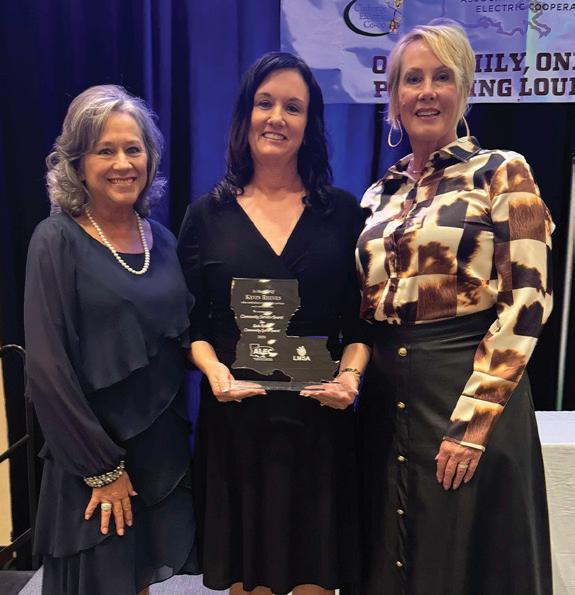
the annual community service award program the Kevin Reeves Cooperative Spirit Award. Kevin’s life was a direct reflection of everything this award symbolizes, and it is a privilege to rename this award program in his honor. No one deserves to be the namesake of this award more than Kevin Reeves.
It was a great honor to have Suszanne accept this award on behalf of Kevin at the 2024 Association of Louisiana Electric Cooperatives Annual Meeting. n
Pruitt for
In the past few years, it has been a goal of Starla’s to better her health through training and competing in 5Ks and half-marathons.In doing so, she races to bring awareness to her favorite causes.
Kevin Reeves Service Award
Since 2018, Starla has competed in more than 20 races that have helped give back to communities across Louisiana and several other states. As soon as Starla realized the impact on the organizations she was running for and the thousands of dollars she could raise, she dedicated her spare time to competing in as many races as she could. n
Beauregard Electric Cooperative’s Kay Fox,
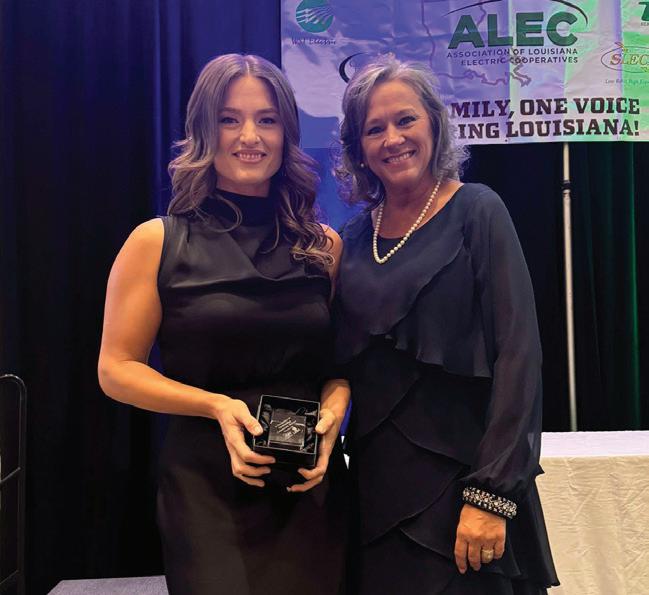
ABOVE: Kevin Reeves served Beauregard Electric Cooperative’s communities and members for 33 years.
LEFT: Suszanne Reeves, middle, accepts the Kevin Reeves Cooperative Spirit Award on behalf of her late husband, Kevin, at the 2024 Association of Louisiana Electric Cooperatives Annual Meeting. Presenting her with the award are Kay Fox, left, and Beama Pierce.
PHOTOS COURTESY OF BECI
right, presents Starla Pruitt with the Kevin Reeves Service Award.

By Victoria Hampton


Create peace of mind with an actionable plan Prioritize Emergency

items your household may need in the event of a shelter-in-place or evacuation emergency. See a list of kit items on page 7.
Be prepared. These two words of advice can make all the difference when facing severe weather and natural disasters. While some severe weather events are seasonal, unpredictable conditions can cause natural disasters to strike any time of year. There is no better time than today to start planning for the next emergency in your community.


During National Preparedness Month, take steps to prepare for what Mother Nature has in store by creating an emergency plan. Emergency plans should account for multiple emergency scenarios. The plan should be developed, discussed and shared with all members of your household.
Take these steps to prepare your emergency plan:
Communicate. Because your family or roommates may not be together when a disaster strikes, make sure everyone knows how to contact one another and where to reconnect.
Discuss the types of disasters that are possible in your area and the different precautions for each. For example, wildfires have different evacuation levels, from 1 to 3. Hurricanes are defined by severity categories. Make sure everyone knows recommendations for sheltering in place and evacuation based on the severity of the natural disaster or storm.
While building your kit, consider the unique needs of each member of your household, such as medication, dietary restrictions, pet supplies and necessities for specific ages. Depending on the size of the household, an emergency kit may be one waterproof container or multiple bins.

If buying extra supplies for an emergency is not in the budget, start with what you already have at home. Collect items in one area to create a new storage spot. Use this nonperishable storage as an extension of your food pantry. Take and replace items after grocery shopping to avoid food waste, and keep the emergency kit stocked at all times. Consider adding additional, non-food items to your kit on a weekly or monthly basis, as finances allow. For emergency kit tasks listed in manageable weekly or monthly steps, search online for a disaster supplies and preparedness calendar.
Ensure the emergency kit is stored in a dry place that is easily accessible for shelter-in-place and evacuation emergencies, such as a garage or closet near the front door. If you leave home for work, make an emergency kit to keep in your vehicle or at your office. Keep in mind, sheltering in place may mean staying at work or a public place if you cannot safely return home.

Talk about how your family would respond to different types of emergencies. Document the plan and share it with each person in the household. Ready.gov offers an easy family emergency communication plan that can be filled out and exported into a shareable PDF.
Expand your emergency plan to include neighbors. Talk about emergency resources or tasks you may be able to share, how to help neighbors who have disabilities or are elderly and how you will communicate with them during a disaster.
Build an emergency kit. A crucial part of creating an emergency plan is building an emergency kit. Emergency kits consist of basic
Sign up for alerts. Finding up-to-date information during an emergency can be stressful. Set up access to emergency alerts beforehand to receive up-to-date information.
Check in with city or county offices of emergency management to sign up for emergency alerts. Signing up for these notifications allows emergency response agencies to text, call or email when a local emergency may require you to shelter in place or evacuate. Local emergency management may also have recommendations for additional alerts and online resources for the most common natural disasters in your area.
The Federal Emergency Management Agency mobile app offers alerts and resources before, during and after a disaster. Get severe



Emergency Preparedness
weather alerts for your area, find local evacuation shelters and disaster recovery centers, save custom emergency information, and receive safety and preparedness reminders. The app is available in English and Spanish. Download for free in the Google and Apple App stores on your smartphone.
Prepare for evacuation. While it may seem unthinkable to have to leave home during severe weather, many kinds of disasters can lead to evacuation. Sometimes there is a day or two to prepare. Other times, a life-threatening situation leads to immediate departure from home.

Prepare evacuation plans by identifying several places to go in an emergency, such as a friend’s house, nearby town or motel. Ask local emergency management about available shelter spaces, and include those options in your plans.


temporarily housed. For small pets, check hotel and shelter policies or ask friends about options at their homes. For large animals, check with local fairgrounds for shelter policies during emergencies, and research additional livestock evacuation locations.
In case of immediate evacuation or shelter-in-place orders when away from home, make sure pets and livestock are microchipped or tagged to expedite reunification efforts post-disaster.
During storm season, keep your vehicle’s gas tank as full as possible. Along with aiding in evacuation to a safer area, vehicles can be used as temporary shelters.

No one wants to deal with the stress and fear of a natural disaster. Yet having a plan for you and your family is the difference between a life-threatening situation and safely weathering the storm.
Choose a variety of locations in different directions. Some of your top choices may be affected by a storm or disaster. For pets and livestock, identify places where they can be
Information for this article was sourced from the United States Department of Homeland Security. Visit ready.gov for free emergencyplanning resources.
Emergency Kit Checklist


An emergency kit is a collection of food, water and supplies that can sustain you and your family for multiple days. When building a kit, choose a waterproof container with a secure lid, such as a storage bin. An emergency kit could be one bin or several, depending on the number of people in your household.
This list is broken into basic items to start a kit and additional recommendations provided by the United States Department of Homeland Security.
At a minimum, your emergency kit should include the following items:
• Bottled water (1 gallon per person per day for several days).
• Nonperishable food.
• Battery-powered or hand-crank radio and a National Oceanic and Atmospheric Association weather radio with tone alert.
• Flashlight.
• First-aid kit.
• Extra batteries
• Whistle to signal for help.
• Dust mask to help filter contaminated air.
• Plastic sheeting and duct tape to shelter in place.
• Moist towelettes, garbage bags and plastic ties for personal sanitation.
• Wrench or pliers to turn off utilities.
• Manual can opener.
• Local maps.
• Cellphone with chargers and a backup battery.
PET CARE ITEMS
• Pet food and water.
• Proper identification.
• A carrier or portable kennel.
• Collar and leash.
• Food and water bowls.
For additional recommended items to add to an emergency kit, visit ready.gov/kit.

A Week to Remember





Louisiana Youth Tour delegates visit Washington, D.C., on weeklong trip
Beauregard Electric Cooperative Inc. sponsored four local students as part of last month’s National Rural Electric Cooperative Association’s Electric Cooperative Youth Tour in Washington, D.C.
Representing BECi were Madelyn Bailey, Brenna George, Jaylon Stephens and Lucian Gaspard, all from East Beauregard High School.
Since BECi began participating in the annual Youth Tour program, dozens of local students have benefited from what has often been described as a life-changing experience. Account No. 128080-003
The local students joined a group of 19 peers and chaperones from electric cooperatives across the state and the Association of Louisiana Electric Cooperatives in Baton Rouge.





Before the trip, students were taught lineworking skills and participated in electrical safety demonstrations. They also learned how to run a cooperative and selected the Louisiana Youth Leader Council Representative among their peers.
Madelyn Bailey, a BECi-sponsored student, was elected by her peers to represent Louisiana. Maddie will be a representative on the National Rural Electric Cooperative Association Youth Leadership Council. The YLC is comprised of one representative from each state that participates in the Youth Tour. Account No. 128629-001


“The purpose of this worthwhile program is to give local students a chance to develop leadership skills, learn how electric cooperatives work, see our government in action and tour Washington, D.C.,” says Kevin Turner, BECi’s acting interim General Manager. “We’re happy that these local students had a great time in Washington and that the cooperative could make this once-in-a-lifetime event possible for them. I know they learned a lot and represented Louisiana well.”
Students visited the World War II, Vietnam, Korean War and Lincoln memorials, Arlington National Cemetery and the Smithsonian Museum Complex. Additionally, the Louisiana students visited the Washington Monument and the Jefferson, Franklin Delano Roosevelt and Martin Luther King memorials.


Delegates, from left, Jaylon Stephens, Lucian Gaspard, Madelyn Bailey and Brenna George visit the Martin Luther King Jr. Memorial in Washington, D.C. PHOTO BY CONLEY BOURGEOIS
‘Takers Eat Well, but Givers Sleep Well’



By Madelyn Bailey
I would like to begin my speech with a thank you to Beauregard Electric Cooperative Inc. for the opportunity to go on such an extensive and informative trip to our nation’s capital. I absolutely adored the Youth Tour and all that it included. I look forward to learning more about my local cooperative as I work alongside you all as this year’s Youth Leader Council.
For as long as I can remember, I have always wanted to visit Washington, D.C., but I never imagined I would receive the opportunity to not only visit there but see so many of the fundamentals that contribute to making D.C. the place it is today.
From the rolling hills of Arlington to looking out over Washington, D.C., from the speaker’s balcony, the Youth Tour was nothing short of absolutely magnificent. Even though I was fully convinced my calves would be able to cut diamonds by the end of the week, and I was left with not an ounce of energy, I would take the opportunity to go back on this adventure in a heartbeat. Account No. 76975-002
I believe the overall takeaway I received from this trip is summarized through a quote from Mike Schlappi, the keynote speaker at our Youth Day event.
“Takers eat well, but givers sleep well,” Mike says.
To me, that encompasses everything it means to be a leader.
As a leader within my community, I must have willingness, determination and passion towards the task at hand, whether it’s planning homecoming week for my school’s student council, volunteering at local festivals or writing the parish report for my position as Student Representative to the School Board for Beauregard Parish. Through these endeavors, I find myself exhibiting to others what it means to be a leader in my community.
With this in mind, I can only hope my work at East Beauregard and the surrounding areas can influence rising leaders.
To close, I would like to take the time to personally recognize and thank the chaperones who watched over us throughout the duration of the trip. Account No. 160759-001
To Mr. Jonathan for keeping us on our toes with your comedy and reminding me so much of my own father.
To Mrs. Tammy, the perfect mix of spunk and energy while somehow being the last one across the crosswalks every single time. But hey, at least we knew everyone was accounted for by the time we made it over.
Governor Nick—if you know you know—I appreciate your efforts as our fearless leader, but mostly for finding and playing the movies we wanted on the way there and back.
Ms. Rhianna, I so greatly appreciate the bond you and I formed by the end of our trip and all the laughs we shared together.
Sweet, sweet Conley, you are everything I have ever wanted in an older sister, as well as exhibiting many of the traits I have wanted in myself. You answered my loads of questions, made sure not a single bit of shellfish got anywhere near me, but the greatest of all, you facilitated my journey to be on this year’s Louisiana YLC.
Thank you all from the bottom of my heart, I will never forget the impact you all had on me. n
Beauregard Electric Cooperative Inc. Youth Tour delegates visited, from top, the Natural Bridge State Park, George Washington’s home and the White House. PHOTOS BY CONLEY BOURGEOIS




&Learning Adapting
By Scott Flood

Unless you’ve just awakened from an especially long nap, you’ve probably been hearing plenty about artificial intelligence. It’s likely that much of what you’ve heard is exciting or terrifying. Movies and TV offer paradises in which technology frees us from daily drudgery—and frightening scenarios in which machines become our overlords.
Venkat Banunarayanan smiles when asked if popular media’s takes on AI are accurate.




“We’re at the stage of discovery with AI,” Venkat says.


What could AI, VR and AR mean for electric co-ops?

“There’s a lot more buzz than reality at this point, and we have a long way to go.”
As the vice president for Integrated Grid Business & Technology Strategies for the National Rural Electric Cooperative Association, Venkat spends some of his time exploring possible use cases with AI, augmented/virtual reality and other technologies, while considering how they might improve the way electric co-ops serve their consumer-members.

“Can AI do things better? Can it handle some of the tasks we have to do today? Can it make decisions for us? The answer to those and most other questions is the same: maybe,” he says.
Industry experts agree it’s impossible to guess where AI will be in another decade or two, but it’s currently not as powerful as the entertainment industry and media seem to think.
AI is being incorporated for specific tasks and activities, including automated solutions such as chatbots that are capable of answering common questions. AI also has the potential to be paired with data analysis, such as retailers using data to better predict customer needs.

Despite what you may have heard, AI is incapable of thinking independently. The functionality greatly depends on programming, how the tool is trained to handle specific tasks and the level of data being fed into the system. AI revolves around learning and adapting to decision-making.



Because these new technologies interface with internal and external systems, Venkat stresses the importance of strong cybersecurity.
“We need to make sure hackers can’t




influence systems,” he says. “When we consider advancements like AI, we need to ensure protection of personal, critical infrastructure, proprietary and confidential data, too.”


Maintaining robust cyber hygiene is important and necessary to deploy any technology reliably and safely—AI is no different.
As electric cooperatives explore the possibilities of AI, they will focus on underlying needs rather than the technology itself. Examining better ways to accomplish tasks and obtain desired results will guide co-ops as they consider AI tools for more efficient processes and approaches.
Despite all the hype, today’s AI is mostly used to make incremental improvements to existing products and services. That’s how electric co-ops are likely to experience the growth of AI in the foreseeable future.

AI Put Into Action
Electric cooperatives already use artificial intelligence and augmented reality for key tasks and activities.

For example, the next generation of smart meters might incorporate AI tools that help homeowners better manage energy use. AI-based systems may also be used to improve management of the nation’s power grid, spotting potential problems before human operators can.
Weather forecasts are likely to become more accurate, pinpointing the areas most likely to experience damage so crews can be stationed there.
Another promising technology being explored is augmented reality, and some co-ops are already testing it, particularly in educational and training opportunities.

For example, apprentice lineworkers can become comfortable with the equipment by working with the AR and VR versions before working with the real thing. Instead of watching a video or a webinar, lineworkers can interact with what they’re doing. Safety training can simulate a hazardous situation, like the aftermath of an ice storm or hurricane, providing lineworkers the opportunity to prepare for the real thing.

Looking ahead, co-ops see great potential for AI and AR as helpful tools for improving grid reliability and the services they provide to consumer-members.
Services for Members
AI tools like chatbots can enhance member interactions and provide a tailored experience based on energy use data.
Weather Forecasting


With the help of AI, weather forecasts will become more accurate, pinpointing areas to station utility crews.
Educational Opportunities
Through augmented reality, lineworkers can experience interactive, lifelike trainings, rather than watching a video or webinar.

atop a power pole. Their safety glasses will instantly recognize the type of transformer, its exact location and when it was installed before displaying a checklist of the equipment the lineworker may need, a guide to diagnosing common problems and 24-hour access to technical experts.
AR blends VR with the world around us.
One day soon, a lineworker may look up at a failed transformer


Ultimately, the adoption of AI, VR, AR and other technologies share one goal for electric co-ops. From solving outages more quickly to allowing consumer-members greater control over their energy use to lowering the cost of service, tomorrow’s innovative technologies will continue to help co-ops enhance the services they provide to communities.






Time for a Fall Tuneup
As summer comes to an end, assess the health of your home to maximize savings
Thermostat
A programmable thermostat allows you to control settings to suit your climate, schedule and temperature preferences.
Consider installing a smart thermostat. After installation, input your schedule and temperature preferences. As you change the settings, the thermostat adjusts to minimize energy use. Bonus: You can control the thermostat remotely with a smartphone.
Don’t adjust the thermostat drastically. Your home will not heat or cool more quickly.
Keep the temperature at or below 68 F during the day and cooler at night.
Save up to 10% on your monthly heating and cooling bill by turning back your thermostat 7 to 10 degrees for eight hours a day.
Windows and Doors
Energy loss and drafts often occur in the cracks between window components. Use weatherstripping where a window’s movable parts meet the window frame.
The seam between the window frame and the wall is a common source of air leakage. Fill any crack less than ¼-inch wide with caulk. For larger cracks, use expanding foam and paint over it. Use window coverings to cut energy costs. Cellular shades, curtains and draperies can provide increased comfort year-round.
Use a door sweep—a flexible piece of rubber or plastic held to the door’s lower edge by a piece of aluminum—on an exterior door to block drafts.
Insulation
Insulation reduces heat loss during winter and heat gain during summer. Before you add or replace insulation, check your current levels. Start with your attic. Aim for at least 14 inches of insulation for warmer climates and at least 18 inches in colder climates. The U.S. Department of Energy recommends an R-value— which refers to the insulation’s ability to resist heat—of about R-60 for most regions.
According to DOE, air leaks are among the most significant sources of energy loss in a home. They also are the easiest to fix. Check for leaks throughout your home, including insulation.
Heating and Cooling
Frequently replacing your furnace filter is one of the easiest and cheapest ways to keep your HVAC system running efficiently. A clogged filter causes your system to work harder and can shorten its life span.
Depending on the home, filters should be changed every month or every other month when the HVAC system is in use.
Schedule an annual service on your HVAC system. A clean system is safer and more efficient. A preventive service call for a tuneup and cleaning usually is less expensive and less stressful than an emergency service call if your equipment fails.
Leaky furnace ducts mean higher utility bills. Improve their performance by sealing exposed ducts in the attic, crawl space, unfinished basement and garage.
Outdoors
Trim shrubs, and clear leaves and other debris. Keep branches away from the house and electrical wires to prevent property damage or power interference. Cut cracked and diseased limbs close to the trunk. For large jobs, hire a pro.
Rake yard debris away from the outdoor compressor unit of your heat pump. A heat pump needs good circulation to work efficiently, so make sure there is a 2-foot clearance around the outdoor compressor.
Ensure gutters are clear and downspouts are correctly connected so water drains away from your home. The dirt grade around your home should slope away from the house.


ADOBE STOCK PHOTO BY SDECORET
